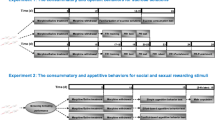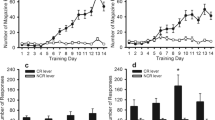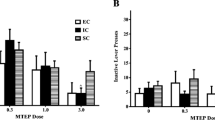Abstract
These experiments compared isolation-reared and socially-reared rats in two complementary paradigms for measuring responding to signals of reward, both undrugged and following either systemic or intraaccumbensd-amphetamine (AMPH). In experiment 1, locomotor activity conditioned to food presentation was measured in rats exposed to a restricted feeding schedule. The interaction between this conditioned activity, AMPH administration (0.5, 2.0, 3.5, 5.0 mg/kg IP) and motivational state was measured. In experiment 2, hungry rats were trained to associate a compound light/noise stimulus with sucrose reward and were then implanted with guide cannulae in the nucleus accumbens. In the test phase, responding on one of two novel levers produced the compound stimulus (conditioned reinforcer; CR). Responses on the other lever had no effect. Each rat received four counterbalanced intra-accumbens infusions of AMPH (0, 3, 10, 20 µg). In both experiments, isolated rats responded more with stimuli associated with reward and this differential rearing effect was further exaggerated by AMPH. The isolation-induced sensitivity to these stimuli and to AMPH was critically dependent on motivational variables. Thus, in experiment 1 there were no differences between the groups when sated or during extinction and in experiment 2 the increased responding was restricted to the lever providing CR. Measurements of the locomotor response to intra-accumbens AMPH (0, 3, 10 µg) also revealed that isolated rats were more sensitive to a low dose of the drug when tested food-deprived in a relatively novel environment. These results suggest that the experience of isolation-rearing interacts either directly or indirectly with dopamine-dependent mechanisms of the nucleus accumbens to enhance the effects of reward-related stimuli.
Similar content being viewed by others
References
Blanc G, Herve D, Simon H, Lisoprawski A, Glowinski J, Tassin JP (1980) Response to stress of mesocortical-frontal dopaminergic neurons in rats after long-term isolation. Nature 284:265–267
Cadon M, Robbins TW, Everitt BJ (1989) Involvement of the amygdala in stimulus-reward associations: interaction with the ventral striatum. Neuroscience 30:77–86
Campbell BA, Fibiger HC (1971) Potentiation of amphetamine-induced arousal by starvation. Nature 233:424–425
Campbell BA, Sheffield FD (1953) Relation of random activity to food deprivation. J Comp Physiol Psychol 46:320–322
Carr G, White N (1983) Conditioned place preference from intraaccumbens but not intra-caudate amphetamine injections. Life Sci 33:2551–2557
Carter CJ, Pycock CJ (1979) The effects of 5,7-dihydroxytryptamine lesions of extrapyramidal and mesolimbic sites on spontaneous motor behaviour, and amphetamine stereotypy. Naunyn-Schmiedeberg's Arch Pharmacol 308:51–54
Chitkara B, Durcan MJ, Campbell IC (1984) Apomorphine-induced stereotypy: function of age and rearing environment. Pharmacol Biochem Behav 21:671–673
Crow TJ, Baker HF, Cross HJ, Joseph MH, Lofthouse R, Longden A, Owen F, Riley GJ, Clover V, Killpack WS (1979) Monoamine mechanisms in chronic schizophrenia: post mortem neurochemical findings. Br J Psychiatry 134:249–256
Devenport LD, Devenport JA, Holloway FA (1981) Reward-induced stereotypy: modulation by the hippocampus. Science 212:1288–1289
Douglas VI (1983) Attentional and cognitive problems. In: Rutter M (ed) Developmental neuropsychiatry. Guilford Press, New York, pp 280–329
Douglas VI, Peters KG (1979) Toward a clearer definition of the attentional deficit of hyperactive children. In: Hale GA, Lewis M (eds) Attention and cognitive development. Plenum Press, New York, pp 173–247
Einon DF, Morgan MJ (1978) Early isolation produces enduring hyperactivity in the rat, but no effects on spontaneous alternation. Q J Exp Psychol 30:151–156
Einon DF, Sahakian BJ (1979) Environmentally induced differences in susceptibility of rats to CNS stimulants and CNS depressants: evidence against a unitary explanation. Psychopharmacology 61:299–307
Einon DF, Stewart J, Atkinson S, Morgan MJ (1976) The effects of isolation on barbiturate induced anaesthesia in the rat. Psychopharmacology 50:85–88
Farley IJ, Price KS, McCullough E, Deck JHN, Hordynski W, Hornykiewicz O (1978) Norepinephrine in chronic paranoid schizophrenia: above normal levels in limbic forebrain. Science 200:456–458
Fibiger HC, Phillips AG (1986) Reward, motivation, cognition: psychobiology of mesotelencephalic dopamine systems. In: Bloom FE (ed) Handbook in Physiology, vol 4. American Physiology Society, Bethesda, MA, pp 647–675
Gentsch C, Lichtsteiner M, Frischknecht HR, Feer H, Siegfried B (1988) Isolation-induced locomotor hyperactivity and hypoalgesia in rats are prevented by handling and reversed by resocialisation. Physiol Behav 43:13–16
Gold LH, Swerdlow NR, Koob GF (1988) The role of mesolimbic dopamine in conditioned locomotion produced by amphetamine. Behav Neurosci 102:544–552
Guisado E, Fernandez-Tome P, Garzon J, Del Rio J (1980) Increased receptor binding in the striatum of rats after long term isolation. Eur J Pharmacol 65:463–464
Hoebel BG, Monaco AP, Hernandez L, Aulisi EF, Stanley BG, Lenard L (1983) Self-injection of amphetamine directly into the brain. Psychopharmacology 81:158–163
Jones DL, Mogenson GJ, Wu M (1981) Injections of dopaminergic, cholinergic, serotoninergic and GABA-ergic drugs into the nucleus accumbens: effects on locomotor activity in the rat. Neuropharmacology 20:29–37
Jones GH, Hernandez TD, Marsden CA, Robbins TW (1988) Enhanced striatal response tod-amphetamine as revealed by intracerebral dialysis following social isolation in rats. Br J Pharmacol 94:349P
Jones GH, Robbins TW, Marsden CA (1989) Isolation-rearing retards the acquisition of schedule-induced polydipsia in rats. Physiol Behav 45:71–78
Juraska JM, Greenough WT, Conlee JW (1983) Differential rearing affects responsiveness of rats to depressant and convulsant drugs. Physiol Behav 31:711–715
Katz DM, Steinberg H (1972) Factors which might modify morphine dependence in rats. In: Van Praag HM, De Ewen F, Bohn NV (eds) Biochemical and pharmacological aspects of dependence and reports on marijuana research. De Erven, Bonn, pp 46–61
Kelley AE, Domesick VB (1982) The distribution of the projection from the hippocampal formation to the nucleus accumbens in the rat: an anterograde- and retrograde-horseradish peroxidase study. Neuroscience 7:2321–2335
Kelley AE, Domesick VB, Nauta WJH (1982) The amygdalostriatal projection in the rat — an anatomical study by anterograde and retrograde tracing methods. Neuroscience 7:615–630
Kelly PH, Seviour PW, Iversen SD (1975) Amphetamine and apomorphine responses in the rat following 6-OHDA lesions of the nucleus accumbens septi and corpus striatum. Brain Res 94:507–522
Lyness WH, Moore KE (1981) Destruction of 5-hydroxytryptaminergic neurons and the dynamics of dopamine in the nucleus accumbens septi and other forebrain regions of the rat. Neuropharmacology 20:327–334
Lyness WH, Friedle NM, Moore KE (1979) Destruction of dopamine nerve terminals in the nucleus accumbens: effects ond-amphetamine self-administration. Pharmacol Biochem Behav 11:553–556
Mackay AVP, Iversen LL, Rosser M, Spokes EG, Bird E, Arregui A, Creese I, Snyder SH (1982) Increased brain dopamine and dopamine receptors in schizophrenics. Arch Gen Psychiatry 39:991–997
Mackintosh NJ (1974) The psychology of animal learning. Academic Press, London
Mogenson GJ, Jones DL, Yim CY (1980) From motivation to action: functional interface between the limbic system and the motor system. Prog Neurobiol 14:69–97
Morgan M, Einon D (1975) Incentive motivation and behavioural inhibition in socially-isolated rats. Physiol Behav 15:405–409
Neill DB, Ross JF, Grossman SP (1974) Comparison of the effects of frontal, striatal, and septal lesions in paradigms thought to measure incentive motivation or behavioural inhibition. Physiol Behav 13:297–305
Paxinos G, Watson C (1982) The rat brain in stereotaxic coordinates. Academic Press, New York
Pellegrino LJ, Cushman AJ (1967) A stereotaxic atlas of the rat brain. Century Croft, New York
Pettit HO, Ettenberg A, Bloom FE, Koob GF (1984) Destruction of dopamine in the nucleus accumbens attenuates cocaine but not heroin self-administration in the rat. Psychopharmacology 84:167–173
Pijnenburg AJJ, Honig WMM, Van der Heyden JAM, Van Rossum JM (1976) Effects of chemical stimulation of the mesolimbic dopamine system on locomotor activity. Eur J Pharmacol 35:45–58
Reynolds GP (1983) Increased concentrations and lateral asymmetry of amygdala dopamine in schizophrenia. Nature 305:527–529
Robbins TW, Everitt BJ (1982) Functional studies of the central catecholamine. Int Rev Neurobiol 23:303–365
Robbins TW, Roberts DCS, Koob GF (1983) Effects ofd-amphetamine and apomorphine upon operant behaviour and schedule-induced licking in rats with 6-hydroxydopamine lesions of the nucleus accumbens. J Pharmacol Exp Ther 222:662–673
Sahakian BJ, Robbins TW (1977) Isolation-rearing enhances tail pinch-induced oral behaviours in rats. Physiol Behav 18:53–58
Sahakian BJ, Robbins TW, Morgan MJ, Iversen SD (1975) The effects of psychomotor stimulants on stereotypy and locomotor activity in socially deprived and control rats. Brain Res Bull 84:195–205
Schenk S, Lacelle G, Gorman K, Amit Z (1987) Cocaine self-administration in rats influenced by environmental conditions: implications for etiology of drug abuse. Neurosci Lett 81:227–231
Schenk S, Robinson B, Amit Z (1988) Housing conditions fail to affect the intravenous self-administration of amphetamine. Pharmacol Biochem Behav 31:59–62
Sheffield FD, Campbell BA (1954) The role of experience in the ‘spontaneous’ activity of hungry rats. J Comp Physiol Psychol 47:97–100
Taylor JR, Robbins TW (1984) Enhanced behavioural control by conditioned reinforcers following microinjections ofd-amphetamine into the nucleus accumbens. Psychopharmacology 84:405–412
Taylor JR, Robbins TW (1986) 6-Hydroxydopamine lesions of the nucleus accumbens, but not of the caudate nucleus, attenuate responding with reward-related stimuli produced by intra-accumbensd-amphetamine. Psychopharmacology 90:390–397
Thoa NB, Tizabi Y, Jacobowitz DM (1977) The effect of isolation on the catecholamine concentration and turnover in discrete areas of the rat brain. Brain Res 131:259–269
Valzelli L (1977) Social experience as a determinant of normal behavior and drug effect. In: Iversen LL, Iversen SD, Snyder SH (eds) Handbook of Psychopharmacology, vol 7. Plenum Press, New York, pp 369–392
Weinstock M, Speiser Z (1973) The effect ofd-propanolol, d-propanolol and practolol on the hyperactivity induced in rats by prolonged isolation. Psychopharmacologia 30:241–250
Werner E, Smith R (1977) Kauai's children come of age. University of Hawaii Press, Honolulu
Winer BJ (1971) Statistical principles in experimental design, 2nd edn. McGraw-Hill, New York
Yang CR, Mogenson GJ (1984) Electrophysiological response of neurones in the nucleus accumbens to hippocampal stimulation and the attenuation of the excitatory response by the mesolimbic dopamine system. Brain Res 324:69–84
Yim CY, Mogenson GJ (1982) Response of nucleus accumbens neurons to amygdala stimulation and its modification by dopamine. Brain Res 239:401–415
Author information
Authors and Affiliations
Rights and permissions
About this article
Cite this article
Jones, G.H., Marsden, C.A. & Robbins, T.W. Increased sensitivity to amphetamine and reward-related stimuli following social isolation in rats: possible disruption of dopamine-dependent mechanisms of the nucleus accumbens. Psychopharmacology 102, 364–372 (1990). https://doi.org/10.1007/BF02244105
Received:
Revised:
Issue Date:
DOI: https://doi.org/10.1007/BF02244105




